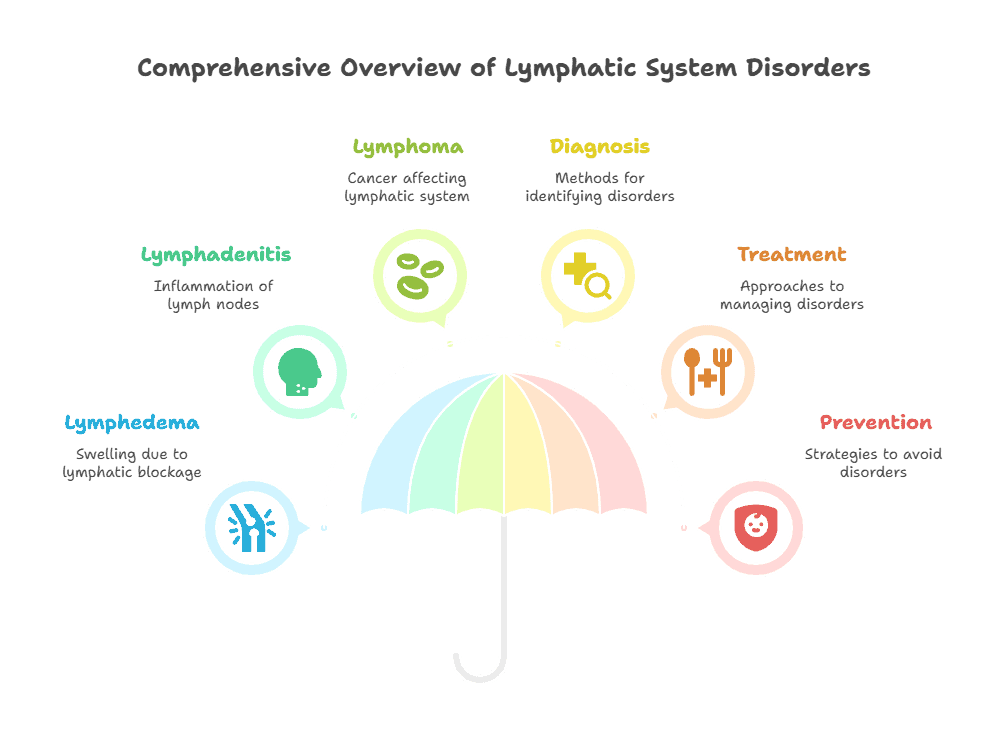The lymphatic system is a crucial part of the body’s immune system, responsible for carrying lymph fluid, white blood cells, and other immune cells throughout the body to fight off infections and diseases. However, like any other system in the body, the lymphatic system can be prone to disorders and diseases that can affect its functioning.
Lymphedema
Lymphedema is a condition where there is swelling in the arms or legs due to a blockage in the lymphatic system, preventing the lymph fluid from draining properly. This can lead to discomfort, pain, and an increased risk of infections. Lymphedema can be either primary (due to a genetic defect in the lymphatic system) or secondary (due to damage to the lymphatic system from surgery, radiation therapy, or infection).
Lymphadenopathy
Lymphadenopathy is a condition where the lymph nodes become enlarged due to infection, inflammation, or cancer. Enlarged lymph nodes can be a sign of an underlying health issue and may require further investigation to determine the cause.
Lymphoma
Lymphoma is a type of cancer that affects the lymphatic system, specifically the lymphocytes (a type of white blood cell). There are two main types of lymphoma: Hodgkin lymphoma and non-Hodgkin lymphoma. Symptoms of lymphoma can include swollen lymph nodes, fever, night sweats, and unexplained weight loss. Treatment for lymphoma may include chemotherapy, radiation therapy, or stem cell transplant.
Lymphangitis
Lymphangitis is an infection of the lymphatic vessels, usually caused by bacteria entering the body through a cut or wound. Symptoms of lymphangitis can include red streaks on the skin, swelling, pain, and fever. Treatment for lymphangitis may include antibiotics and rest.
Summary
The lymphatic system plays a vital role in the body’s immune response, but it can be susceptible to disorders and diseases that can impact its functioning. Lymphedema, lymphadenopathy, lymphoma, and lymphangitis are just a few examples of conditions that can affect the lymphatic system. It is important to be aware of the symptoms of these disorders and seek medical attention if needed to ensure proper diagnosis and treatment.
Key Takeaways:
- Understanding the lymphatic system disorders and diseases is essential for diagnosing and treating patients effectively.
- Lymphedema is a common disorder that results in swelling due to a blockage in the lymphatic system.
- Lymphadenitis is the inflammation of the lymph nodes, often caused by an infection.
- Lymphoma is a type of cancer that affects the lymphatic system, including lymph nodes and lymphocytes.
- Diagnosing lymphatic system disorders often involves physical exams, imaging tests, blood tests, and biopsies.
- Treatment for lymphatic system disorders may include medications, physical therapy, surgery, or radiation therapy.
- Preventative measures for lymphatic system disorders include maintaining a healthy lifestyle, avoiding infections, and managing chronic conditions.
Key Terms:
- Lymphatic System Disorders: Conditions that affect the lymphatic system, such as lymphedema, lymphadenopathy, and lymphoma.
- Lymphedema: Swelling caused by the accumulation of lymph fluid in the tissues, often as a result of damage to the lymphatic system.
- Lymphadenopathy: Enlargement of lymph nodes, often due to infection or inflammation.
- Lymphoma: Cancer of the lymphatic system, which includes Hodgkin’s lymphoma and non-Hodgkin’s lymphoma.
- Primary Lymphedema: Lymphedema that is present at birth or develops later in life due to a genetic defect in the lymphatic system.
- Secondary Lymphedema: Lymphedema that develops as a result of damage to the lymphatic system, such as surgery, radiation therapy, or infection.
- Filariasis: A parasitic infection that can lead to lymphedema, characterized by swelling of the limbs.
- Lymphangitis: Inflammation of the lymphatic vessels, often caused by bacterial infection.
- Lymphangiosarcoma: Rare cancer that develops in the lymphatic vessels.
